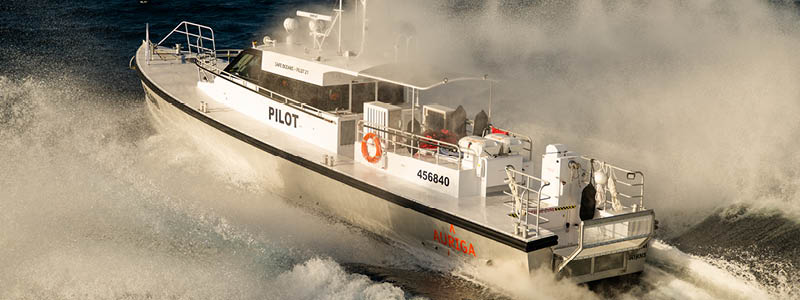Safe Oceans -Pilot 21 boat review
- Words & Photography by James Dumergue - Originally published in Trade A Boat Magazine
The primary driving force for most new designs is a need. The design of the Safe Oceans 21 tackles the fundamental needs of operational ease, comfort and efficiency with such modest agility, it opens the door for this all-weather design to bring fuel-saving comfort to a multitude of commercial applications.
Queensland based Safe Oceans set about to design a new pilot boat, extensive operational experience in Pilotage includes shallow waters with steady tidal streams and strong winds. The right combination for short fetches and high slamming loads which are tough on boats and even tougher on personnel. They’re also the type of conditions that limit the operational capability of typical planing hull pilot boats.
A planing hull can typically endure the G Forces a lot better than a human body. Anyone who has to go against the grain in shallow waters can attest to the punishment at almost all speeds let alone at high speed as required for reliable pilotage operations.
Studies show the long term musculoskeletal effects of operating high-speed vessels with repetitive vertical G forces, create injuries and result in higher operational costs. If crew are comfortable in a boat made to suit the challenging conditions, then operational windows will be broader, with minimal crew downtime.
To build a boat that goes against the conditions often, Safe Oceans had to go a little against the grain of popular theory to achieve the lofty goals they set. Several years of research led to the design. The requirement for excellent performance in rough seas dictated the hull design. Safe Oceans chose a round-bottomed displacement hull rather than the flat-bottomed planing hull that was more typical for this size and desired cruising speed. Using a Low Displacement Length (LDL) ratio hull and a novel approach to sectional shapes, the distribution of buoyancy is longitudinally balanced, creating an excellent ride.
Safe Oceans drew up the hull forms and lines, general arrangements and machinery layouts, technical references for the hull form and lines came from the National Physical Laboratory. A series of data for high-speed semi-displacement round bilge hull forms helped confirm the direction was on course for success. Still, it was the extensive tank testing that gave rise to the final design.
Three different iterations of the hull form were tank tested at 1:10 scale over several months for resistance, trim, dynamic stability and seakeeping performance. The tank test models were constructed of fibreglass by the Australian Maritime College to details provided by Safe Oceans. After more than 200 runs in the towing tank, extracting a great deal of data from these tests was obtained.
Wave buoy data collected over five years from the area of operations combined with extensive operational experience in the field ensured the validity of the data coming out of the tank test for the intended conditions. The total model resistance, model scale speed and forward and aft sinkages were measured. A concerted effort to concentrate weight close to the longitudinal centre of flotation and keep the ends of the vessel light has proven to reduce pitching moments dramatically.
The initial tank test results from version one were sent to renowned Naval Architects Donald L Blount & Associates/Gibbs & Cox U.S.A. – (major design contractors to U.S.A. Navy and Coast Guard) for review of the design and the tank testing data. They came back with suggestions to the design ratios. The hull form modifications were implemented into testing models two and three.
Extensive tank testing led to slenderness ratio adjustments, deadrise variations, the centre of buoyancy tweaks and the transom immersion ratio modifications. It resulted in the third iteration seeing a 20% improvement in efficiency compared to version one.
Donald L Blount & Associates reviewed the final design and confirmed it as “fit for purpose.” With that tick of approval, Australian Naval Architect Andrew MacDonald Smith created the detailed structural fabrication engineering required and construction began at the Gold Coast City Marina and Shipyard.
When the new design emerged from the shed to splash down for its first time it garnered some interest as it passed through the shipyard, it looks understatedly capable. The fabrication is exceptional; it’s a robust and well-built boat that is full of intrigue.
Leaving the Gold Coast Seaway a 1.5m – 2.0m metre E.S.E. swell running, this commissioning test run was not about dodging the less desirable swells but more of a case of hunting them down with an invincible attitude. Once you pass over your first couple of swells, the jostling and need to prepare for impact subsides, and the pleasure derived from the suppleness of the ride can take over.
Maintaining the boat at a nearly horizontal attitude has created a very efficient hull, the fine-entry bow with no hard chine and only a spray rail is uncommon in vessels that are capable of at least 28 knots. Quite different to modern high-speed design conventions but not an unfamiliar design from history. Many high-speed torpedo-carrying boats of World War 2 employed similar longitudinal buoyancy distribution techniques. Utilising slender low displacement length hulls to operate in the challenging North Sea conditions with speed and efficiency, enabling a vaster range of operations.
Round bilge sections have produced high ultimate transverse stability together with a soft roll period which reduces transverse G-Forces and aids tracking in a following sea. The longitudinal extremities of the bow and stern are light too, which has helped maintain that desirable running attitude and minimised the vertical forces both factors contributing to quite a stable yet natural motion with the sea state.
Underway and the hydraulically powered active fin stabiliser system provide additional ride comfort. At one stage we went beam on at low speed to the swell. The inshore swell passing over the bar at the Gold Coast Seaway was steep enough to create a significant roll effect, but the actual impact of the swell was minimal even at low speed. At high speed, the hydraulic fin stabilisers complement the hull’s seaworthiness well with a beam sea.
At speed, running into the conditions, there is no radical change in vertical height crossing the swells. Typically these conditions would have a significant rise and fall at these speeds in a planing hull. A combination of the fine-entry and no chine allows the hull to slice through the top of the swell and the rounded hull shape of 21 metres minimises the rise and fall with a very sublime suppleness. It’s truly a remarkable ride, piercing the top of the waves with a near-horizontal attitude has lifted the stern, allowing higher speeds with lighter more efficient engines.
Engine room accessibility was a crucial consideration in the design – personnel access from the protected position in the cockpit with a watertight thru-bulkhead door providing safe access underway. Twin-engine Scania 700HP 6 cylinder main engines power fixed pitch propellers through, Z.F. remote mount transmissions. The ability to use lighter six-cylinder engines is a significant reduction in build and operational costs. The V-drive transmission configuration is to optimise the shaft angle and weight distribution, provide ease of access to and rapid removal to all significant components. The whole machinery space has good standing headroom throughout, and there is easy access to all service points such as belts, shaft seals, fuel filters, seawater strainers etc.
The high bow and surprisingly capable spray rails keep the working deck impressively dry. Safe Oceans has created broad flat working surfaces and thoughtfully positioned working bollards either viewable from the helm or accessible from protected areas serviced by a sail track harness system. Forward is a heavy-duty anchoring arrangement that is well protected for on-deck operations or controlled remotely from the wheelhouse. At the stern, there is a straightforward and effective M.O.B. recovery and resuscitation zone set up for helicopter evacuation. Equipped with high-end S.A.R. electronics including FLIR and RDF this configuration is well suited to other applications outside of Pilotage.
The air-conditioned cabin seats seven crew in suspended comfort, each chair is an impact absorbing fully adjustable model from Be-Ge of Sweden. Swedish input includes the application of ergonomic geometries developed over by Dr Johan Ullman based on two decades of medical, scientific research and practical experience designing dashboards, steering consoles and wheelhouses. The interior ergonomics and sightlines were modelled in 3-D by Marsh Duffield Studios to ensure all-round and upward visibility are possible without the operator having to leave normal helm position during all stages of vessel operations.
The ever-important but often underdelivered night vision considerations have also been carefully studied with an emphasis on night lighting and dimming systems to preserve the night vision of the Pilots.
The first Safe Ocean’s Pilot 21 went straight into operation after commissioning; the commissioning crew were very impressed by the vessels all-round performance during its’ initial 1,500 NM delivery voyage from the Gold Coast to Thursday Island. Since going into service, the master has commented:
“I conducted my transfer at 9kts today and did not have any troubles at all. Transit at 1,650 RPM, 20 knots, 65% engine load, approx 55 Litres/hour each side. Held alongside really well using both motors, a lot easier to break free from the ship using helm only. Vessel handles well, and interaction with the ship was not felt at all. Any weather the vessel has encountered on the head has been smooth and held speed. The electronics onboard are amazing and make our life easy and the operation more professional.”
The Safe Oceans 21 is a remarkable ocean-going design, and it is built strong, is efficient and affords significant savings in fuel over existing choices. After several years to ruminate the solution, Safe Oceans has produced a great boat that is an apt culmination of knowledge, experience and science, a vessel that is capable of applying itself to a multitude of commercial applications.

